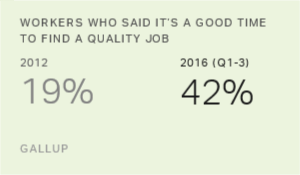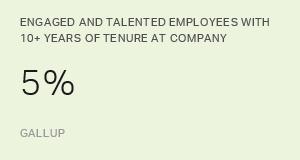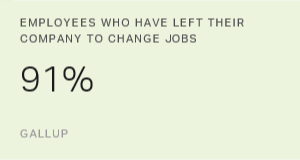Story Highlights
- Not all workers are benefiting from expanded job opportunities
- On the positive side, hiring has picked up
- Workers' optimism about employment opportunities is rising
This is the first article in a two-part series.
The U.S. job market presents a mixed picture for workers: Some find it bleak, while others are confident and ready to look for new jobs. Your best employees may be among the latter group -- and could be looking to leave.
First, the bad news: New business startups are at historical lows, and those that do get off the ground are growing at slow rates. According to the U.S. Small Business Administration, 65% of all new jobs are created by small businesses, not large ones. For job creation to thrive, the U.S. needs a resurgence of small businesses.
While it's true that the U.S. has a high number of job openings, not all workers are benefiting from expanded opportunities, according to Gallup's State of the American Workplace report. People without the skills to fill much-needed roles are finding it more difficult to secure full-time employment with decent wages.
Millennials have the highest rates of unemployment and underemployment, and those who hold full-time jobs often struggle to pay their bills. Gallup also finds that college graduates believe they are overqualified for their current job, meaning they have more education than the role requires.
Considering these realities, it's clear why people in the U.S. continue to drop out of the labor force in alarming numbers. In some cases, they can't find a job or the right job. In others, they can't find a job that pays enough to justify incurring the costs that sometimes go along with working, such as child care or transportation.
The U.S. Bureau of Labor Statistics (BLS) reports that the percentage of the total U.S. adult population with a full-time job has been hovering around 48% since 2010 -- the lowest full-time employment level since 1983. More jobs may be available, but they're not always the jobs people can or want to fill.
Encouraging News: Hiring Is Up
But there's encouraging news on the jobs front: Hiring has picked up. Gallup's U.S. Job Creation Index represents the percentage of workers who say their employers are hiring new people minus the percentage who say their employers are letting people go. In 2012, the Job Creation Index averaged +18. For the first three quarters of 2016, it averaged +32.
And worker optimism is on the rise. Typically, when a relatively high number of employees voluntarily leave their job, this signals greater confidence among workers who believe they have more and better options. The number of Americans voluntarily leaving their job in August 2012 was 2.1 million. In December 2015, BLS data showed that the number of Americans who voluntarily left their job reached a post-recession high of nearly 3.1 million workers. In August 2016, the number still stood at 3 million workers.
Gallup data support this feeling of improved optimism. Americans have increasingly positive perceptions of the job market and what it offers. In 2012, an average of 19% said it was a good time to find a quality job. For the first three quarters of 2016, an average of 42% said the same. Among those in the labor force (employed, unemployed or looking for work), the number was even higher, at 47%.
Americans' confidence that they can find a job as good as their current one if they happen to be laid off has also bounced back. Currently, 63% of employed U.S. adults believe it is "very likely" or "somewhat likely" that they would find a job as good as the one they have, up from 42% who said the same in 2010. The current figure is similar to what Gallup measured in early 2007 before the recession.
There's definitely room for improvement in these metrics, but they reflect important changes in employees' views. Whether perception or reality, people increasingly see opportunity in the job market -- meaning your best employees could be looking to leave.
The second article in this series will focus more closely on employees who are looking for new jobs and leaving their current ones.
This article is part of Gallup's State of the Workplace Initiative. To learn more, we invite you to:
- download the most recent State of the American Workplace report
- attend a complimentary briefing in your area about this initiative



